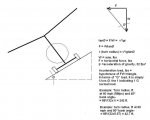- Joined
- Oct 30, 2003
- Messages
- 18,390
- Location
- Santa Maria, California
- Aircraft
- Givens Predator
- Total Flight Time
- 2600+ in rotorcraft
I am trying to understand angle of bank and G loading on a gyroplane.
How many Gs are required to get a gyroplane to maintain 80 degrees of bank?
I have seen and believed explanations about why it is not 4 Gs. I found I was not able to articulate and defend the explanation.
I seem to be confused on a low level.
The question that I couldn’t answer well was “how much pull would be on a string that had a one pound ball attached for the string to get to an angle of 80 degrees from the horizontal?”
Thank you, Vance
How many Gs are required to get a gyroplane to maintain 80 degrees of bank?
I have seen and believed explanations about why it is not 4 Gs. I found I was not able to articulate and defend the explanation.
I seem to be confused on a low level.
The question that I couldn’t answer well was “how much pull would be on a string that had a one pound ball attached for the string to get to an angle of 80 degrees from the horizontal?”
Thank you, Vance

